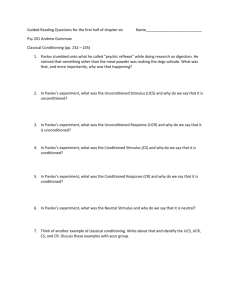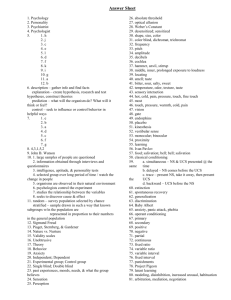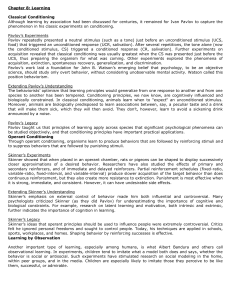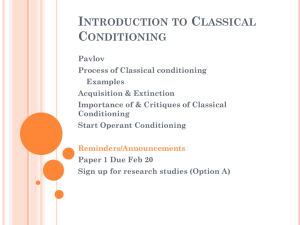Chapter 5: Learning
advertisement
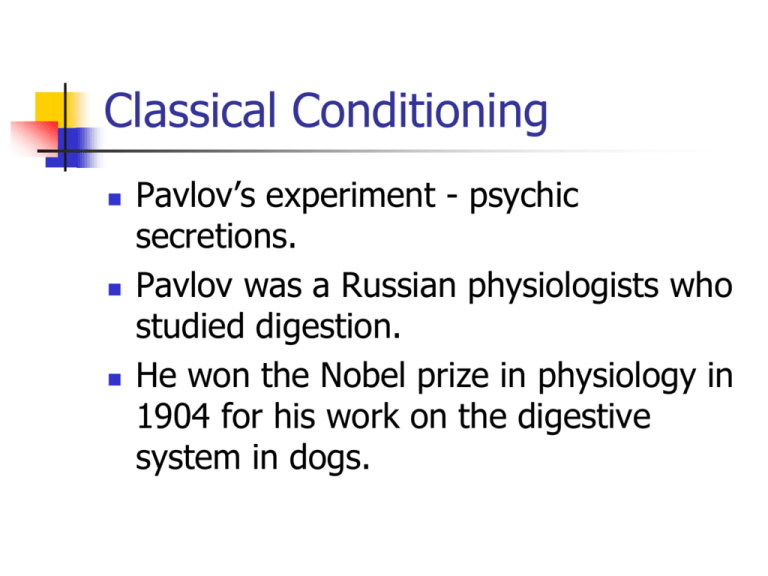
Classical Conditioning Pavlov’s experiment - psychic secretions. Pavlov was a Russian physiologists who studied digestion. He won the Nobel prize in physiology in 1904 for his work on the digestive system in dogs. Classical Conditioning Psychic Secretions. Some of Pavlov’s work with his dogs involved placing objects on the dog’s tongue and measuring the amount of saliva produced. Sand more than marbles amnt’s of food. He noticed that some of his dogs began to salivate before food powder was put on their tongues. Psychic secretions. Similar to your pet getting excited at the sight of you picking up it’s food bowl. He found that stimuli associated with food produced similar amounts of saliva as did actual food Pavlov recognized that this salivation to stimuli associated with food was just as reflexive (out of the animals control) as was food on the tongue. The conditioned reflex. Pavlov set about trying to understand how conditioned reflexes occur. The Unconditioned Response (UCR) This is a reflexive response to certain stimuli that animals are born with Food = salivation tapping knee = knee Jerk puff of air on eye = eye blink The Unconditioned Stimulus (UCS) The stimulus that causes an unconditioned response is the unconditioned stimulus. It is a stimulus animals are born to respond to. Food = salivation tapping knee = knee Jerk puff of air on eye = eye blink The Conditioned Stimulus (CS). The conditioned stimulus is some stimulus that the experimenter presents that predicts an unconditioned stimulus. Pavlov paired the sound of a bell (CS) with placement of food (UCS) in a dog’s mouth. If you sound a bell and then immediately put food in a dog’s mouth what happens? It salivates (UCR). The conditioned response (CR). If you sound a bell (CS) and immediately place food (UCS) in a dogs mouth, several times, what will happen if you just ring the bell? Test = Bell (CS) alone = salivation Salivating to the bell in the absence of food powder is called a conditioned response (CR). This reflects learning. Summary of Classical Conditioning CS -->UCS = UCR bell -->food = salivation do this several times and then test with the CS alone CS = CR bell = salivation Twitmeyer’s patellar conditioning Twitmeyer was examining the human knee jerk reflex at the same time Pavlov was studying salivation in dogs. UCS - hammer on knee UCR - Knee Jerk He had a bell (CS) that sounded when the hammer’s fell. One day he accidentally rang the bell without dropping the hammer (What happened)? Classical conditioning phenomena Acquisition Extinction Spontaneous recovery Stimulus Generalization train with one tone test with others Discrimination One tone means food, one does not. Instrumental Conditioning Thorndike Chicks and Mazes Cats and puzzle boxes Were there signs of reasoning abilities? The law of effect A response followed by a pleasant consequence will become more likely Satisfying state of affairs A response followed by an unpleasant consequence will become less likely Dissatisfying state of affairs Reinforcement - an event that increases the future probability of the most recent response. RF stamps in a response Punishment – an event that decreases the future probability of the most recent response. Punishment stamps out a response. Very mechanistic Skinner and the operant chamber (Skinner box). Rats get levers Pigeons get keys Now you had an easily quantifiable response. Operant conditioning (Instrumental conditioning) The process of changing behavior by following a response (operant) with reinforcement. What’s the difference between operant and classical conditioning? Operant vs. Classical Conditioning In operant conditioning the subject’s behavior determines an outcome and is affected by that outcome. Response – stimulus change in behavior Touch stove – get burned less likely to touch the stove In classical conditioning, the subjects learn that two stimuli go together. Usually that some stimulus (sight or sound) that is paired with something the organism likes (food) or dislikes (pain). Stimulus – Stimulus change in behavior See Stove – get burned fear stove Reinforcement vs Punishment Skinner defined these terms by their outcomes. Anything that increases the likelihood of a response is a reinforcer Anything that decreases the likelihood of a response is a punisher. Is food a reinforcer? Reinforcement Positive reinforcement Negative reinforcement Both increase behavior but for positive Reinforcement something good happens. for negative Reinforcement something bad is taken away. Punishment Positive punishment Negative punishment Both serve to decrease behaviors positive punishment involves giving something to you for your behavior (something bad) whereas negative punishment involves taking something away (something good). Try these Rat stops pressing a bar because each time he does he gets shocked Rat presses a bar to stop shock from occurring Rat presses a bar because each time he does he gets food Rat stops pressing a bar because pressing the bar causes food to be delayed from when it would normally occur





